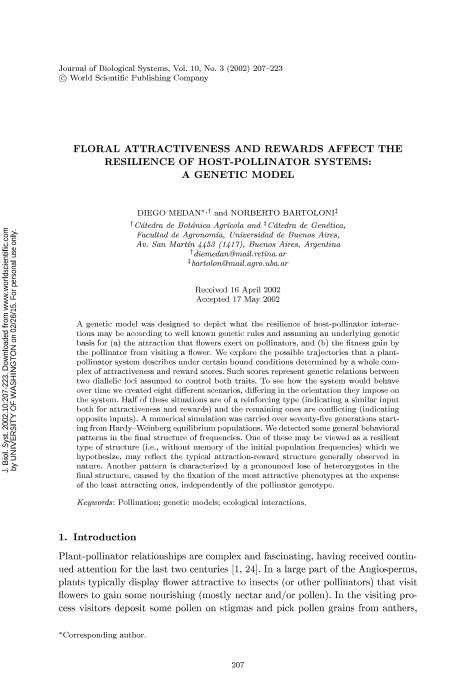Mostrar el registro sencillo del ítem
dc.contributor.author
Medan, Diego

dc.contributor.author
Bartoloni, Norberto Jose

dc.date.available
2022-01-06T18:52:38Z
dc.date.issued
2002-09
dc.identifier.citation
Medan, Diego; Bartoloni, Norberto Jose; Floral attractiveness and rewards affect the resilience of host-pollinator systems: A genetic model; World Scientific; Journal of Biological Systems; 10; 3; 9-2002; 207-223
dc.identifier.issn
0218-3390
dc.identifier.uri
http://hdl.handle.net/11336/149731
dc.description.abstract
A genetic model was designed to depict what the resilience of host-pollinator interactions may be according to well known genetic rules and assuming an underlying genetic basis for (a) the attraction that flowers exert on pollinators, and (b) the fitness gain by the pollinator from visiting a flower. We explore the possible trajectories that a plant-pollinator system describes under certain bound conditions determined by a whole complex of attractiveness and reward scores. Such scores represent genetic relations between two diallelic loci assumed to control both traits. To see how the system would behave over time we created eight different scenarios, differing in the orientation they impose on the system. Half of these situations are of a reinforcing type (indicating a similar input both for attractiveness and rewards) and the remaining ones are conflicting (indicating opposite inputs). A numerical simulation was carried over seventy-five generations starting from Hardy-Weinberg equilibrium populations. We detected some general behavioral patterns in the final structure of frequencies. One of these may be viewed as a resilient type of structure (i.e., without memory of the initial population frequencies) which we hypothesize, may reflect the typical attraction-reward structure generally observed in nature. Another pattern is characterized by a pronounced lose of heterozygotes in the final structure, caused by the fixation of the most attractive phenotypes at the expense of the least attracting ones, independently of the pollinator genotype.
dc.format
application/pdf
dc.language.iso
eng
dc.publisher
World Scientific

dc.rights
info:eu-repo/semantics/openAccess
dc.rights.uri
https://creativecommons.org/licenses/by-nc-sa/2.5/ar/
dc.subject
ECOLOGICAL INTERACTIONS
dc.subject
GENETIC MODELS
dc.subject
POLLINATION
dc.subject.classification
Otras Ciencias Agrícolas

dc.subject.classification
Otras Ciencias Agrícolas

dc.subject.classification
CIENCIAS AGRÍCOLAS

dc.title
Floral attractiveness and rewards affect the resilience of host-pollinator systems: A genetic model
dc.type
info:eu-repo/semantics/article
dc.type
info:ar-repo/semantics/artículo
dc.type
info:eu-repo/semantics/publishedVersion
dc.date.updated
2022-01-03T14:03:13Z
dc.identifier.eissn
1793-6470
dc.journal.volume
10
dc.journal.number
3
dc.journal.pagination
207-223
dc.journal.pais
Singapur

dc.description.fil
Fil: Medan, Diego. Universidad de Buenos Aires. Facultad de Agronomía. Departamento de Recursos Naturales y Ambiente. Cátedra de Botánica Agrícola; Argentina. Consejo Nacional de Investigaciones Científicas y Técnicas. Oficina de Coordinación Administrativa Parque Centenario; Argentina
dc.description.fil
Fil: Bartoloni, Norberto Jose. Universidad de Buenos Aires. Facultad de Agronomía. Departamento de Biología Aplicada y Alimentos. Cátedra de Genética; Argentina
dc.journal.title
Journal of Biological Systems

dc.relation.alternativeid
info:eu-repo/semantics/altIdentifier/url/https://www.worldscientific.com/doi/abs/10.1142/S0218339002000603
dc.relation.alternativeid
info:eu-repo/semantics/altIdentifier/doi/http://dx.doi.org/10.1142/S0218339002000603
Archivos asociados
